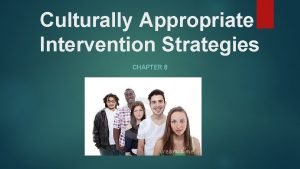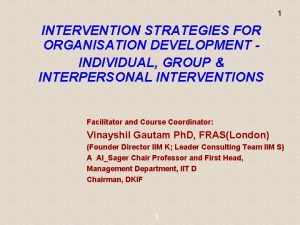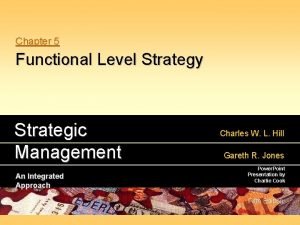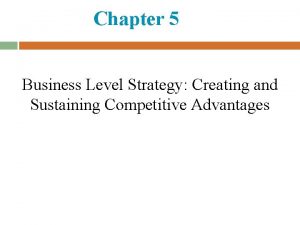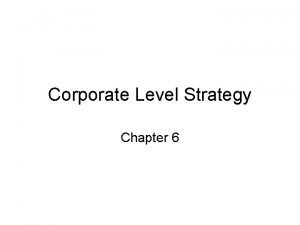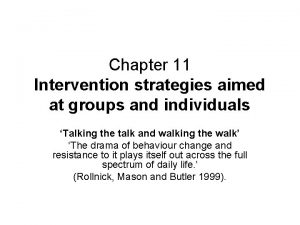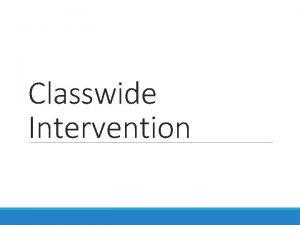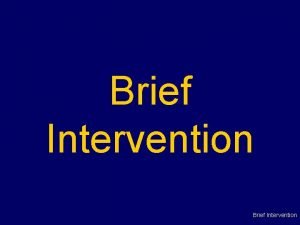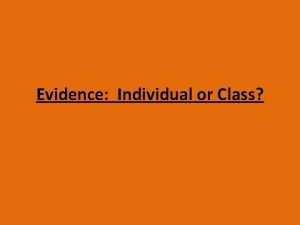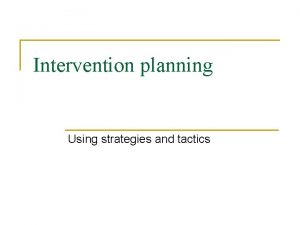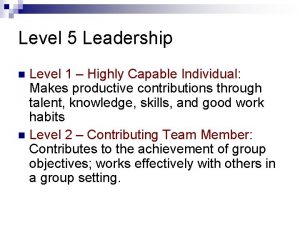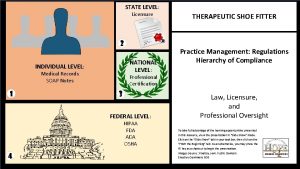Individual Interventions Chapter 17 INDIVIDUAL LEVEL INTERVENTION STRATEGIES

















- Slides: 17

Individual Interventions Chapter 17

INDIVIDUAL LEVEL INTERVENTION STRATEGIES • Behavior change • Modifying people’s behavior: – • Luckily,

• Intervention is:

INTERVENTIONS DEFINED • Interventions broken down into 2 trials: – Efficacy trials: – – E. g. , – Effectiveness trials: – – E. g. ,

OVERVIEW OF THE EFFECTIVENESS OF INDIVIDUAL INTERVENTIONS • Meta-analysis: (Dishman & Buckworth, 1996) – – the IV ______ the DV ______. – Limitations with some meta-analysis?

Effect size r= 0 r=. 20 r=. 40 r=. 60 r =. 80 50% 60% 70% 80% 100% % chance of intervention adherence

Participant Characteristics • impact of an intervention program was identical for – – – •


Type Of Intervention • • •

Behavior Modification • Based on ______techniques (B. F. Skinner, 1947). – – e. g. , – These conditions are called____ – Once cued by an antecedent

Behavior Modification • Consequence of the response. • Scenario 1: A person approaches the elevator and sees the heart smart sign. It is the person’s first time at this elevator, she sees the sign and takes the stairs. Once at the top, she realizes how good that made her feel and she also beat the elevator to the top. Because of this positive reinforcement, she will take the stairs again.

Behavior Modification • Scenario 2: A person approaches the elevator and has seen the signs many times before. The stairway is dirty, cold and empty. In this scenario, there is no reinforcing consequence associated with taking the stairs, but there is a reinforcing consequence take the elevator (safer). It is likely that the antecedent cue of this heart smart sign is not enough to elicit the behavior of taking the stairs in this scenario. •

Behavior Modification • Katz and Nirbhay (1986) • Aim: • Stimulus control= • Prior to the sign being used. .

Behavior Modification • Reinforcement – –

Cognitive Behavioral Techniques • • • 1 2 3 4 5

Intervention Setting • 1. – • 2.

Intervention features Mode Frequency Duration Intensity Measure
 Tbi intervention strategies
Tbi intervention strategies Grid od program
Grid od program Culturally appropriate intervention strategies
Culturally appropriate intervention strategies Group intervention strategies
Group intervention strategies Mezzo level intervention
Mezzo level intervention System-level intervention
System-level intervention Group level intervention
Group level intervention Types of corporate level strategies
Types of corporate level strategies Functional level strategy
Functional level strategy 5 business level strategies
5 business level strategies Aggregate planning in operations management
Aggregate planning in operations management Value neutral diversification
Value neutral diversification Community intervention chapter 11
Community intervention chapter 11 Soft words safewards
Soft words safewards Planning phase in nursing process
Planning phase in nursing process Nursing process
Nursing process Collaborative interventions nursing
Collaborative interventions nursing Jchco
Jchco


